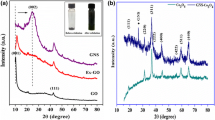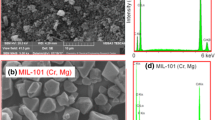Abstract
Electrode materials derived from Metal–organic frameworks (MOF) are becoming interesting materials for supercapacitor application due to their high porous frameworks for facilitating mass and charge transfer. However, the low electrical conductivity and short cycling stability limited their practical application. Herein, reduced graphene oxide/cobalt sulphide nanoparticles derived from MOF with better electrical and ionic conductivity is reported for supercapacitor application. In this work first reduced graphene oxide (rGO) sheet is prepared using sulphur as a template material. Then, the rGO sheet is decorated with abundant cobalt sulphide nanoparticles derived from MOF particles. In this hybrid material the rGO nanosheets served as a physical support backbone with good electrical and ionic conductive layer. On the other hand, the abundant cobalt sulphide nanoparticles decorated on rGO sheets enhanced pseudocapacitive performance of the material. Using this synergistic property, high specific capacitance of 1827 F g−1 at 3 A g−1, high retention capability of 81% at a current density of 15 A g−1 and cycling stability of 82% after 5000 cycles of charge–discharge are obtained. This work shows that hybridizing rGO with MOF-derived materials are promising approach in designing advanced energy storage devices.






Similar content being viewed by others
References
G. Yua et al., Hybrid nanostructured materials for high-performance electrochemical capacitors. Nano Energy 2, 213–234 (2013)
B.E. Conway, Electrochemical Supercapacitors: Scientific Fundamentals and Technological Applications (Kluwer Academic/Plenum Publisher, New York, 1999)
Z. Yong et al., Progress of electrochemical capacitor electrode materials: a review. Int. J. Hydrog. Energy 34, 4889–4899 (2009)
A. Burke, Ultracapacitors: why, how, and where is the technology. J. Power Sources 91, 37–50 (2000)
S. Patrice, Y. Gogotsi, Materials for electrochemical capacitors. Nat. Mater. 7, 845–854 (2008)
S. Patrice, G. Yury, B. Dunn, Where do batteries end and supercapacitors begin? Science 343, 1210–1211 (2014)
W. Guoping, Z. Lei, J. Zhang, A review of electrode materials for electrochemical supercapacitors. Chem. Soc. Rev. 41, 797–828 (2012)
P.D. Deepak et al., Nickel cobaltite as an emerging material for supercapacitors: an overview. Nano Energy 11, 377–399 (2015)
L. Zhang et al., Nickel-based materials for supercapacitors. Mater. Today 25, 35–65 (2019)
F. Wang et al., Latest advances in supercapacitors: from new electrode materials to novel device designs. Chem Soc Rev. 46, 6816–6854 (2017)
S. Sahoo et al., Advances in pseudocapacitive and battery-like electrode materials for high performance supercapacitors. J. Mater. Chem. A 10, 13190–13240 (2022)
M.I. da Silva et al., Recent progress in water-splitting and supercapacitor electrode materials based on MOF-derived sulfides. J. Mater. Chem. A 10, 430–474 (2022)
D. Sheberla et al., Conductive MOF electrodes for stable supercapacitors with high areal capacitance. Nat. Mater. 16, 220–224 (2017)
Z. Hong et al., MOF-derived nanohybrids for electrocatalysis and energy storage: current status and perspectives. Chem. Commun. 54, 5268–5288 (2018)
C. Kang et al., Metal-organic framework derived hollow rod-like NiCoMn ternary metal sulfide for high-performance asymmetric supercapacitors. Chem. Eng. J. 427, 131003 (2022)
J. Choi et al., Metal-organic framework-derived cobalt oxide and sulfide having nanoflowers architecture for efficient energy conversion and storage. J. Energy Storage 50, 104145 (2022)
Wu. Hao Bin, X.W.D. Lou, Metal-organic frameworks and their derived materials for electrochemical energy storage and conversion: promises and challenges. Sci. Adv. (2017). https://doi.org/10.1126/sciadv.aap9252
Xu. Guiyin et al., Exploring metal organic frameworks for energy storage in batteries and supercapacitors. Mater. Today 20, 191–209 (2017)
X. Cao et al., Hybrid micro-/nano-structure, derived from metal–organic frameworks: preparation and applications in energy storage and conversion. Chem. Soc. Rev. 46, 2660–2677 (2017)
W. Cao et al., Metal-organic framework derived carbon-coated spherical bimetallic nickel-cobalt sulfide nanoparticles for hybrid supercapacitors. Electrochim. Acta 385, 1388 (2021)
B. He et al., Freestanding metal−organic frameworks and their derivatives: an emerging platform for electrochemical energy storage and conversion. Chem. Rev. 122, 10087–10125 (2022)
P. Cai et al., ZIF-67 derived nickel cobalt sulfide hollow cages for high-performance supercapacitors. Appl. Surf. Sci. 504, 144501 (2020)
Z. Li et al., Hollow C-LDH/Co9S8 nanocages derived from ZIF-67-C for high- performance asymmetric supercapacitors. J. Colloid Interface Sci. 604, 340–349 (2021)
S. Kavian et al., High-rate supercapacitor based on NiCo-MOF-derived porous NiCoP for efficient energy storage. J. Mater. Sci. 32(10), 13117–13128 (2021)
Z. Xie et al., Recent progress in metal-organic frameworks and their derived nanostructures for energy and environmental applications. Chemsuschem 10, 1645–1663 (2017)
Q. Dou et al., Emerging trends in anion storage materials for the capacitive and hybrid energy storage and beyond. Chem. Soc. Rev. 50, 6734–6789 (2021)
W. Zhang et al., Graphene-carbon nanotube @ cobalt derivatives from ZIF-67 for All-Solid-State asymmetric supercapacitor. Appl. Surf. Sci. 568, 150929 (2021)
H. Niu et al., MOFs-derived Co9S8-embedded graphene/hollow carbon spheres film with macroporous frameworks for hybrid supercapacitors with superior volumetric energy density. J. Mater. Chem. A 7, 8503–8509 (2019)
Q. Yuqing et al., In situ-grown heterostructured Co3S4/CNTs/C nanocomposites with a bridged structure for high-performance supercapacitors. ACS Omega 6(49), 33855–33863 (2021)
J. Liu et al., MOF-derived hollow Co9S8 nanoparticles embedded in graphitic carbon nanocages with superior Li-ion storage. Small 12, 2354–2364 (2016)
U. Patil et al., Nanostructured pseudocapacitive materials decorated 3D graphene foam electrodes for next generation supercapacitors. Nanoscale 7, 6999 (2015)
J. Yang et al., Electroactive edge site-enriched nickel–cobalt sulfide into graphene frameworks for high-performance asymmetric supercapacitors. Energy Environ. 9, 1299–1307 (2016)
Z. Xian et al., Co/Co9S8@S, N-doped porous graphene sheets derived from S, N dual organic ligands assembled Co-MOFs as superior electrocatalysts for full water splitting in alkaline media. Nano Energy Nano Energy 30, 93 (2016)
J. Shi et al., Electrodeposition of high-capacitance 3D CoS/graphene nanosheets on nickel foam for high-performance aqueous asymmetric supercapacitor. J. Mater. Chem. A 3, 20619–20626 (2015)
Yu. Dingshan et al., Scalable synthesis of hierarchically structured carbon nanotube–graphene fibres for capacitive energy storage. Nat. Nanotechnol. 9, 555–562 (2014)
M.D. Stoller et al., Graphene-based ultracapacitors. Nano Lett. 8, 3498–3502 (2008)
S.-L. Jian et al., Designing a carbon nanotubes-interconnected ZIF-derived cobalt sulfide hybrid nanocage for supercapacitors. J. Mater. Chem. A 7, 1479–1490 (2019)
X. Han et al., Design of a porous cobalt sulfide nanosheet array on Ni foam from zeolitic imidazolate frameworks as an advanced electrode for supercapacitors. Nanoscale 10, 2735–2741 (2018)
K. Tao et al., A metal–organic framework derived hierarchical nickel–cobalt sulfide nanosheet array on Ni foam with enhanced electrochemical performance for supercapacitors. Dalton Trans. 47, 3496–3502 (2018)
Acknowledgements
We are thankful for the financial support of this work from China Post-doctoral Science Foundation (Grant No. 2018M633511), the National Natural Science Foundation (Grant Nos. 61671368, 61172041, 91123018 and 61404103), Basic Public Welfare Research Planning Project of Zhejiang Province (LGG19F040002) and the Fundamental Research Funds for the Central Universities. Finally, the we are thankful to Dire Dawa university for financial support during writing and editing of this manuscript.
Funding
This research was funded by China Post-doctoral Science Foundation, Grant no [2018M633511].
Author information
Authors and Affiliations
Contributions
LGB, WL and XL contributed in design of the research. Dr. Lemu Girma Beka conducted the experiment and drafting the manuscript.
Corresponding author
Ethics declarations
Conflict of interest
The authors declare no conflict of interest.
Additional information
Publisher's Note
Springer Nature remains neutral with regard to jurisdictional claims in published maps and institutional affiliations.
Rights and permissions
Springer Nature or its licensor (e.g. a society or other partner) holds exclusive rights to this article under a publishing agreement with the author(s) or other rightsholder(s); author self-archiving of the accepted manuscript version of this article is solely governed by the terms of such publishing agreement and applicable law.
About this article
Cite this article
Lemu, G.B., Liu, W. & Li, X. Reduced graphene oxide/cobalt sulphides nanoparticle derived from metal–organic framework for supercapacitor application. J Mater Sci: Mater Electron 34, 115 (2023). https://doi.org/10.1007/s10854-022-09462-5
Received:
Accepted:
Published:
DOI: https://doi.org/10.1007/s10854-022-09462-5




